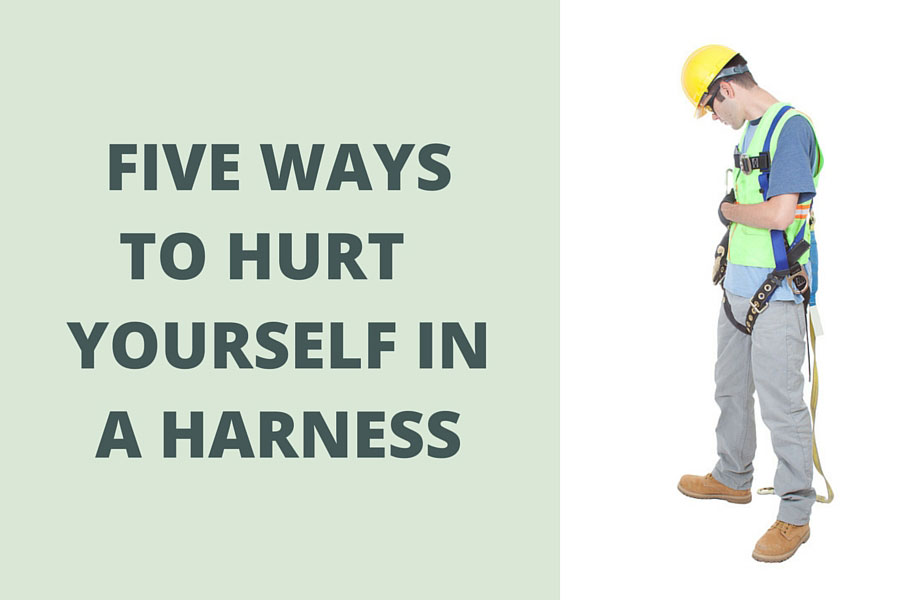Five Ways to Hurt Yourself in a Harness

There are some things you can hand to somebody with no instructions and they’ll know how to use them: a pair of boots, a pair of gloves, safety glasses. A fall protection harness is not one of these things. To the untrained eye, a harness is just a jumble of straps and buckles with no semblance of reason. Wearing a harness improperly could render it ineffective, leaving the user hurt…or worse. So, how could wearing a harness get you hurt?
1. Your D-ring is in the wrong position.
Harnesses weren’t thrown together haphazardly with some straps that were laying around on a manufacturing floor. They were designed by engineers to take the forces exerted on your body in a fall and distribute them so that your fall can be safely arrested. Wearing the harness wrong will ensure that those forces do not get equally distributed and can almost guarantee that you will get hurt. When your back D-ring is in the wrong position, it is a sure sign that you are wearing the harness wrong. When you don your harness, have a partner check to see that the D-ring is situated exactly halfway between your shoulder blades. That does not mean it can just be in the center of your back – it must be in the center of your back at shoulder blade height. If you find it pulling to one side or another, you’ve overtightened one side of your harness. If you find it too high or too low, the harness may not be the correct size for you.
2. You’ve clipped your lanyard to the wrong D-ring.
Speaking of D-rings, many harness models have multiple D-rings. You may be tempted, for the sake of convenience, to attach your fall-arrest lanyard to a front or side D-ring. Don’t. Of course, those D-rings exist for a reason: positioning. Some workers need to work at heights in areas where a platform doesn’t exist (think of a utility worker up on a pole or an ironworker having to tie rebar on a pour-in-place wall). The front or side D-rings allow for the connection of a positioning lanyard, so that the worker may attach, lean back comfortably, and use both hands for their work. If you were to attach your fall arrest harness to a side or front D-ring and fall, the forces encountered in the fall would not be properly distributed, causing your body to “snap” to a stop. If that sounds painful, there’s a reason.
3. Your harness is too loose (or too tight).
A properly sized harness is not just a matter of comfort, it is a matter of life or death. Again, harnesses are designed to be used a certain way. Yes, all models are adjustable, but even those adjustments have limits. It is not okay to reach the last grommet, or pull a strap as tight or loose as it goes, and just say, “Oh, well, I guess that’s got to be good enough.” If you can’t adjust your harness to fit you, it is not the right size. Let’s look at the leg straps as a perfect example. If the leg straps are too loose, in a fall you would continue downward into them at a great force instead of you and the harness having your descent arrested together. This could cause rupturing in the place those leg straps would finally end up – right between your legs. If the straps are too tight, they could cut off circulation, causing a whole host of other problems. The rule of thumb for leg straps is that you should be able to fit a flat hand between the strap and your leg, but not a fist. Adjust your harness to the proper fit and if you can’t, get a new one.
4. Your chest strap is too high (or low).
This may sound like I’m repeating myself, but the truth is, you can be wearing a proper size harness and not adjust things correctly. The chest strap is a good example. You could adjust it to what feels like the proper width and still have it on wrong (hence, the need for training). A chest strap worn too high could choke you or injure your throat/jaw/etc. in a fall, while a chest strap worn too low could allow you to slip out of the harness if your fall were to turn into a head-first one.
5. Your straps are twisted.
Twisted straps could reduce the strength of your harness significantly. Any time you don a harness, have a second person check it to make sure they don’t see anything wrong with it and that no straps are twisted because there are places you cannot check once the harness is on. Harnesses are intended to save your life, so check, check, and re-check.
In the end, harnesses are not just some silly tool or piece of equipment that can be used without care. They are life-saving devices, and it’s your life that depends on them working properly. Coincidentally, you are the only one that can ensure they work properly by using them as they are intended to be used, and by wearing them as they are designed to be worn.
In addition to proper adjustment, make sure your harness is in the right condition. Learn more about checking the condition of your safety equipment.


